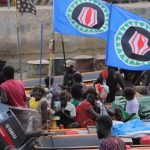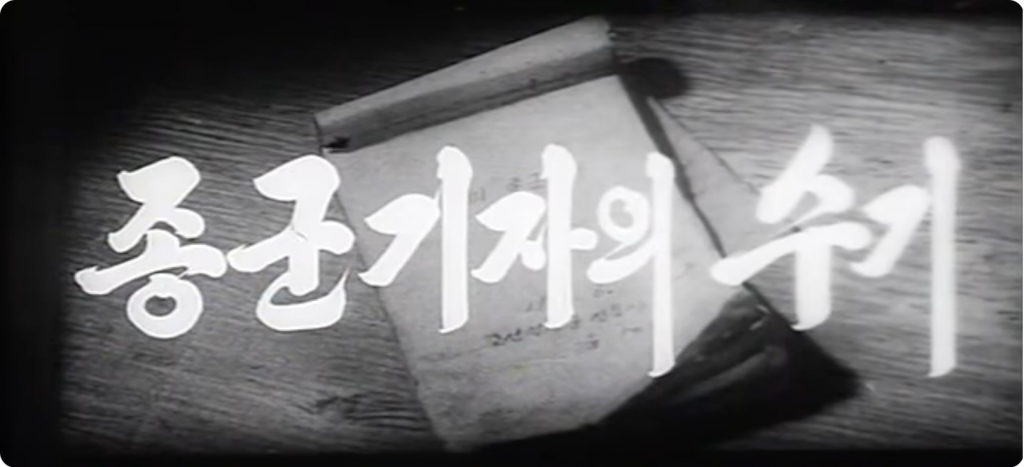
Overview of the 1982 DPRK Film Notes of a War Correspondent:
The 1982 DPRK film Notes of a War Correspondent (Korean Title: 종군기자의 수기), directed by Choe Bu-kil, is an interesting entry in the DPRK wartime canon, partly because all circulating copies are in black and white. That is strange given that DPRK films had been produced in color since the early seventies and this title appears during the period when Kim Jong Il was aggressively modernizing the industry and promoting more technically ambitious productions. Whether the monochrome survives because the color print has been lost or because it was actually shot that way is unclear, but it does look like it was deliberately photographed in black and white. Perhaps it was an artistic choice. At a brisk 76 minutes, which is lean by DPRK film standards where multi part epics often run two hours per segment, the film moves quickly and does not drag.
Notes of a War Correspondent Synopsis:
The story begins in modern day with notes and film being recovered from the wreckage of the Korean People’s Navy vessel mine layer no. 225 which was sunk in June 1951 while laying mines in Marine zone no. 56 . These notes belonged to a young KPA war correspondent who had joined a naval unit on its mine laying mission. In modern day, the top brass of the KPA examines the notes and the correspondent’s photographs which segways into a flashback…

The film opens on a battlefield in 1951. Amid the chaos of an enemy bombing run, war correspondent Hye Kyong (played by a young O Mi ran, who would soon rise to prominence in DPRK cinema with her starring role in 1987’s A Broad Bellflower) drops her camera as she dives for cover. Captain Kim Kum Sok appears through the smoke, retrieves it, and presses it back into her hands. “Here is your camera. Are you insane? Who reports if you are bombed?” he snaps. She stoically replies: “War would be impossible if everybody was afraid of dying.” In the span of three minutes, the film states its thesis with absolute clarity, setting the tone for everything that follows.
Back at headquarters, Captain Kim is informed that his minelaying mission has been reassigned because he is to report to Pyongyang to meet with “The General” (Kim Il Sung). He refuses, insisting that he cannot present himself before The General while his mission has been handed to someone else. He argues that the mission will only take two hours and that he should complete one more mission before he goes to Pyongyang.
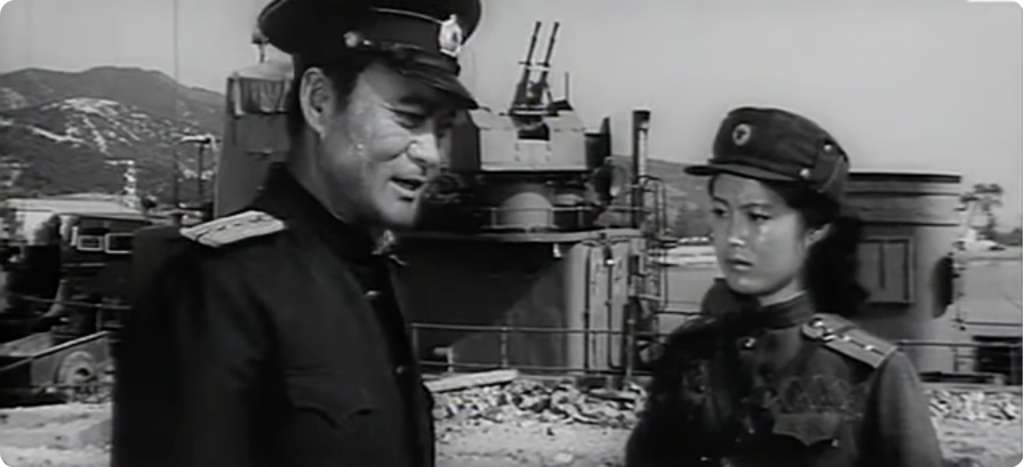
Hye Kyong asks to accompany the mission so she can better profile Captain Kim. He refuses at first, but she insists that without joining them she cannot write the true story. After a moment of hesitation, he relents.
As Kim Jong Il wrote in his film treatise On the Art of Cinema: “A film without singing is no film at all.” True to that principle, as the minelayer heads out to sea we are treated to a classic, catchy DPRK film number “We Shall Live Forever To Defend Our Seas,” performed by the Mansudae Art Troup.
The steam whistle is going tenderly through the naval port,
The evening sun is burning on the swelling waves,
Fly, fly the heroic flag,
Brave sailors go on the path of struggle.
The sound of firing is hear over the horizon,
The fierce fight takes through the night,
Fly high the red and blue naval ensign,
Brilliant exploits are embroidered along the loyal route.
The song remains a staple of the Korean People’s Navy to this day, and an extended suite of the film’s score, built around this piece and the main theme, was later released on vinyl as part of Korean Film Music Vol. 4.
On their return from the mission, the minelayer is suddenly surrounded by a US warship and a minesweeper. In a moment driven by both desperation and duty, Captain Kim orders his crew and Hye Kyong to take the flag and evacuate. They reluctantly obey. With the enemy closing in, he rams the minelayer into the US warship, triggering a massive explosion. At the last possible moment, he leaps from the deck just before the vessel erupts in flames.
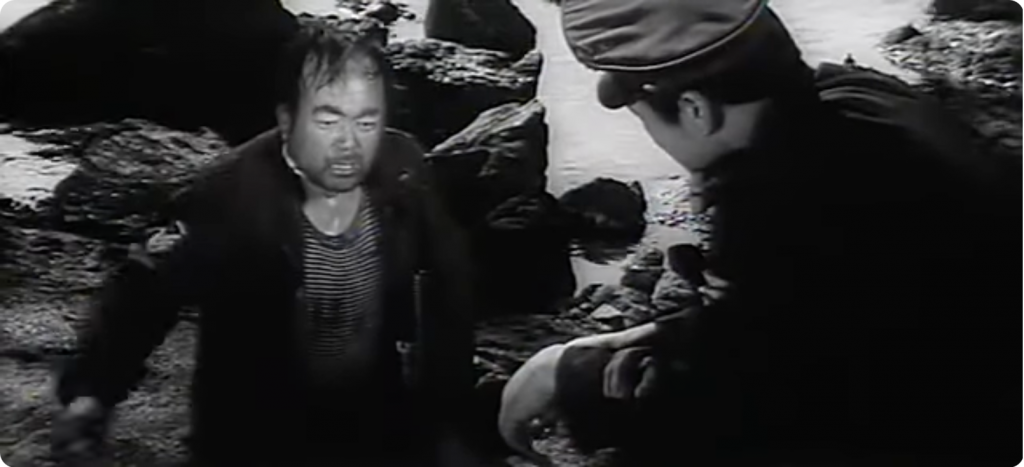
Stranded on an uninhabited island, they seize a boat crewed by ROK soldiers and, during interrogation, learn of a newly established US radar installation that the KPN knows nothing about. Captain Kim realizes that this radar will detect and destroy the KPN minelayers scheduled to pass through the area the following day. Understanding that their comrades’ lives depend on it, the stranded unit undertakes a voluntary suicide mission to eliminate the installation. They succeed in destroying the radar station, but their escape fails. Knowing they likely will not survive, Hye Kyong seals her notes about the mission and her film in a metal tube. Overwhelmed by US naval firepower, they die in a blaze of glory aboard their captured ROK vessel, the tattered DPRK flag flying defiantly above them.
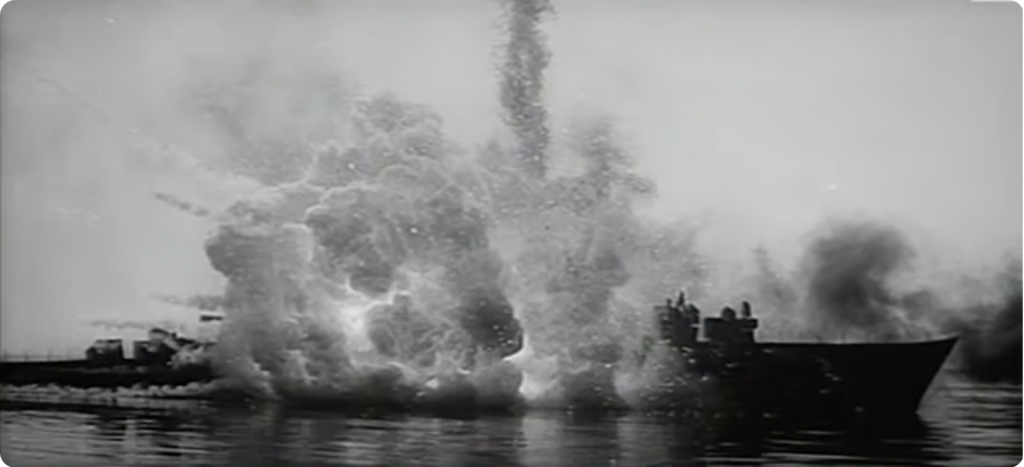
Notes of a War Correspondent Review:

As noted above, the film features an early, strong performance by actress O Mi ran would go on to become one of the DPRK film industry’s most celebrated performers, starring in major productions such as A Broad Bellflower, a role that earned her the honorary title of People’s Artiste, as well as the long running television epic Nation and Destiny. She won the Best Acting Award at both the first and second Pyongyang International Film Festivals, and in 1990 she was named Best Korean Actress at the first New York Inter Korean Film Festival. After her death from breast cancer in 2006, she was laid to rest in the Patriotic Martyrs’ Cemetery, where Kim Jong Il personally placed a wreath at her grave. Although director Choe Bu kil’s complete filmography is difficult to confirm, he likewise went on to direct several episodes of the 62-part television series Nation and Destiny.
The sea battle scenes are surprisingly well executed, reportedly filmed with the assistance of the KPA’s 853rd and 518th units. The staging is confident and the imagery suggests the filmmakers had access to real naval personnel and authentic equipment. The patriotic messaging is present but not hammered in. The characters talk about wanting to survive in order to attend a planned military meeting with Kim Il Sung, but the film avoids the standard martyr’s send off where the fallen shout slogans with their final breath. What complicates the propaganda even more is a small moment when the female correspondent wonders, in an interior monologue, what it would be like to be the Captain Kim’s partner, which is rare to see those kinds of impulses presented on screen in a DPRK film.
The closing sequence is genuinely effective. Senior officers wait at the naval base knowing the unit will never return. As ranks of sailors march by, the fallen unit appears at the head of the formation. It is a classic socialist realist flourish, but is effective.

Overall, this DPRK film finds a clever angle on familiar wartime themes and largely avoids the usual heavy handed propaganda, which makes it a far more engaging and accessible watch.
For more information on DPRK film history, check out my blog: Spreading The Rays of Juche: Five North Korean Films You Must-See!




